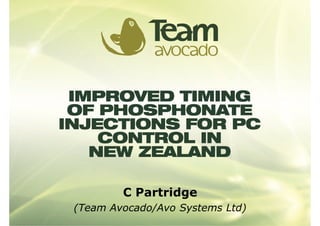Colin Partridge
- 1. C Partridge (Team Avocado/Avo Systems Ltd)
- 2. âĒ Soil applied Ridomil, Aliette foliar sprays and trunk painting were early Pc control measures. âĒ Injection technology initiated in early 1980âs. âĒ Injection has since become a method of controlling Pc worldwide.
- 3. âĒ Using low pressure syringes, a buffered phosphonate solution is injected into the trunks of avocado trees. âĒ Uptake time can vary considerably. âĒ Phosphonate moves up the tree in the xylem and then down to the root system via the phloem. âĒ Phosphonate accumulated in the root system protects against invasion by Pc.
- 5. âĒ Understanding the phenological growth cycles of the tree â âsink strengthâ of different plant parts varies over time. âĒ Establishing critical root phosphonate concentrations required to attain Pc control (20-30ppm). âĒ Development of a commercial plant tissue phosphonate analysis service. (Darvas, Pegg, Whiley, Thomas et al)
- 7. âĒ Phosphonate applied aerially to Jarrah forests to control Pc in W Australia. âĒ Found that such applications severely reduced pollen viability of Jarrah. âĒ Trial done on avocados, found that in vitro, phosphonate concentrations of 2000ppm+, severely reduced avocado pollen germination.
- 8. âĒ Foliar applications of phosphonate to avocados should be avoided at flowering, especially if conditions for fruitset are known to be less than ideal. âĒ Provided this is done, no negative affects should be found.
- 9. âĒ We donât foliar spray in NZ - it is being found to be less effective than injecting in Australia as well (Thomas et al)âĶâĶâĶ. we INJECT our trees. âĒ We often have conditions less than favourable for fruitset.
- 10. âĒ For very sick trees, one could argue that almost any time is a good time to inject. âĒ Injection timing recommendations vary from country to country (different phenological cycling). âĒ For NZ â âbest administered during summer between early spring (July/Aug) and a secondary injection in the New Year periodâ. âWhere actively growing shoots are present, phosphonate remains fixed in leaf tissue and does not reach the rootsâ. (Cutting & AIC Growers Manual)
- 11. âĒ For âhealthyâ trees, I think not, because:- 1. July/Aug/Sep is a time when expanding flower buds are the strongest sink. 2. If phosphonate can negatively affect pollen viability, that would make early spring an even worse time to inject. 3. Commercial root phosphonate monitoring gave indications that July/Aug treatment often gives poor phosphonate persistence in the roots.
- 12. 4. Feb/Mar treatment however, appears to give persistence for up to 11 months in many cases. This makes sense, since shoot flushes are more mature and roots are becoming a stronger sink at this time.
- 13. Grower Injected Analysed ppm A Sep 01 Sep 02 16 B Sep 02 Jan 03 12 C Aug 02 Jan 03 26 D Feb 02 Aug 02 34 D Feb 02 Jan 03 21 E Mar 02 Jan 03 90
- 14. âĒ Two sites (Lankshear & Cotterell) were chosen âĒ Treatments at both sites as follows:- (all sites â 5 trees per treatment) -Inject in Aug 03 with 15% HiPK -Control (no injection)
- 15. âĒ Phosphonate concentrations in the roots prior to injecting. âĒ Phosphonate concentrations in the roots and developing flower buds at various times after treatment.
- 17. Cotterell roots 250 200 Concentration (mg/kg) Treated 150 Control 100 50 0 18-Aug 8-Sep 2-Oct 3-Dec 5-Feb Sample date
- 18. Lankshear roots 250 200 Concenetration (mg/kg) control treated 150 100 50 0 18-Aug 8-Sep 2-Oct 3-Dec 5-Feb Sample date
- 19. Cotterell Flowers 250 200 Treated Concentration (mg/kg) Control 150 100 50 0 18-Aug 8-Sep 2-Oct 3-Dec 5-Feb Sample Date
- 20. Lankshear Flowers 250 Treated 200 Control concentration (mg/kg) 150 100 50 0 18-Aug 8-Sep 2-Oct 3-Dec 5-Feb sample date
- 21. âĒ Root phosphonate concentrations for Aug injected trees, dropped to below the threshold of 30ppm within 5 months at Lankshear. âĒ Flower phosphonate levels peaked rapidly, reaching 200ppm â flower tissue is a strong âsinkâ.
- 22. âĒ There is a question mark about a 200ppm effect on pollen viability under field conditions. âĒ Would the concentration be more dilute in large trees? âĒ From commercial results for healthy trees, injecting in Feb/Mar appears to be a âbetterâ time to inject and would be my recommendation if injecting once per year in New Zealand.
- 23. âĒ Feb/Mar is a more âcomfortableâ time to inject. âĒ In Feb/Mar, uptake is much faster. âĒ For very large trees, 15% sometimes still struggles to achieve a root level above 30ppm â consider using 20% on large trees if injecting once per year.
- 24. âĒ Aongatete Coolstores for financial assistance. âĒ Aongatete field staff for doing the injecting. âĒ J & C Cotterrell & J Lankshear for use of their trees. âĒ H Pak for trial design & data analysis. âĒ T Whiley, G Thomas & S Ogle for helpful discussion.























